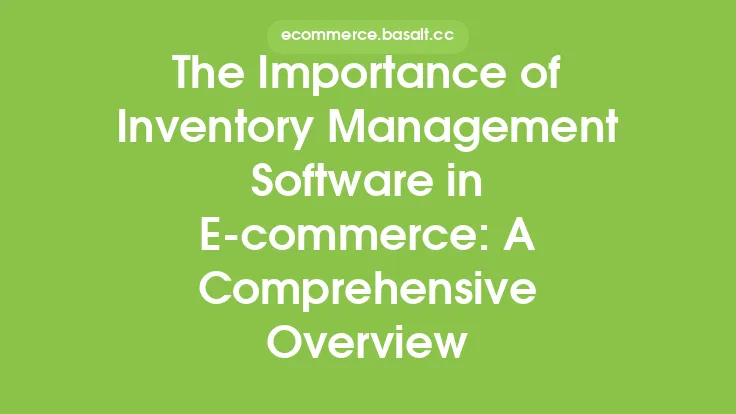In the world of e-commerce, managing inventory effectively is crucial for driving business growth and maintaining a competitive edge. As online retailers continue to navigate the complexities of the digital marketplace, they must prioritize inventory management to ensure they can meet customer demand, reduce costs, and maximize profits. At its core, inventory management involves the planning, organizing, and controlling of inventory levels to meet customer demand while minimizing waste and excess stock. When done correctly, it can have a significant impact on an e-commerce company's bottom line and overall success.
Introduction to Inventory Management
Inventory management is a critical component of e-commerce operations, as it directly affects a company's ability to fulfill customer orders, manage costs, and maintain a competitive edge. Effective inventory management involves a range of activities, including forecasting demand, managing stock levels, and optimizing storage and shipping processes. By implementing a robust inventory management system, e-commerce businesses can reduce the risk of stockouts, overstocking, and other inventory-related issues that can negatively impact customer satisfaction and revenue.
Benefits of Effective Inventory Management
There are numerous benefits to effective inventory management in e-commerce, including improved customer satisfaction, reduced costs, and increased efficiency. When inventory levels are optimized, businesses can ensure that they have the right products in stock to meet customer demand, reducing the risk of stockouts and backorders. This, in turn, can lead to increased customer satisfaction and loyalty, as customers are more likely to return to a retailer that can consistently meet their needs. Additionally, effective inventory management can help businesses reduce waste and excess stock, which can result in significant cost savings and improved profitability.
Key Components of Inventory Management
There are several key components of inventory management that e-commerce businesses must consider, including demand forecasting, inventory tracking, and supply chain management. Demand forecasting involves analyzing historical sales data and market trends to predict future demand for products. This information can be used to inform inventory decisions, ensuring that businesses have the right products in stock to meet customer demand. Inventory tracking, on the other hand, involves monitoring inventory levels in real-time to ensure that businesses can quickly respond to changes in demand or supply. Supply chain management is also critical, as it involves managing the flow of goods from suppliers to customers, ensuring that products are delivered quickly and efficiently.
Inventory Management Strategies
There are several inventory management strategies that e-commerce businesses can use to optimize their inventory levels and improve their overall operations. One popular strategy is the just-in-time (JIT) inventory system, which involves ordering and receiving inventory just in time to meet customer demand. This approach can help businesses reduce waste and excess stock, as well as minimize storage and handling costs. Another strategy is the economic order quantity (EOQ) model, which involves calculating the optimal order quantity to minimize costs and maximize efficiency. By implementing these and other inventory management strategies, e-commerce businesses can improve their inventory management and drive business growth.
Technology and Inventory Management
Technology plays a critical role in inventory management, as it enables businesses to track inventory levels in real-time, automate inventory processes, and analyze sales data to inform inventory decisions. Inventory management software, for example, can help businesses monitor inventory levels, track orders, and optimize inventory levels to meet customer demand. Additionally, technologies such as radio-frequency identification (RFID) and barcode scanning can be used to track inventory levels and automate inventory processes, reducing the risk of human error and improving overall efficiency. By leveraging these and other technologies, e-commerce businesses can streamline their inventory management and improve their overall operations.
Best Practices for Inventory Management
There are several best practices that e-commerce businesses can follow to improve their inventory management, including regularly reviewing inventory levels, implementing a first-in, first-out (FIFO) inventory system, and providing training to inventory management staff. Regularly reviewing inventory levels can help businesses identify areas for improvement and optimize their inventory levels to meet customer demand. Implementing a FIFO inventory system, which involves selling or using older inventory first, can help businesses reduce waste and excess stock, as well as minimize the risk of inventory becoming obsolete. Providing training to inventory management staff can also help businesses improve their inventory management, as it ensures that staff have the skills and knowledge needed to manage inventory effectively.
Conclusion
In conclusion, inventory management plays a critical role in e-commerce growth, as it directly affects a company's ability to meet customer demand, manage costs, and maintain a competitive edge. By implementing effective inventory management strategies, leveraging technology, and following best practices, e-commerce businesses can improve their inventory management and drive business growth. As the e-commerce landscape continues to evolve, it is essential that businesses prioritize inventory management to ensure they can stay ahead of the competition and meet the changing needs of their customers. By doing so, they can improve customer satisfaction, reduce costs, and increase efficiency, ultimately driving long-term success and growth.





